Standards Worldwide
Standards Worldwide
Phone +49 30 58885700-07

Standard [CURRENT]
ASTM D 6891:2023
Standard Test Method for Evaluation of Automotive Engine Oils in the Sequence IVA Spark-Ignition Engine
- Publication date
- 2023
- Original language
- English
- Pages
- 46
- Publication date
- 2023
- Original language
- English
- Pages
- 46
- DOI
- https://dx.doi.org/10.1520/D6891-23
Product information on this site:
Quick delivery via download or delivery service
Buy securely with a credit card or pay upon receipt of invoice
All transactions are encrypted
Short description
1.1 This test method measures the ability of crankcase oil to control camshaft lobe wear for spark-ignition engines equipped with an overhead valve-train and sliding cam followers. This test method is designed to simulate extended engine idling vehicle operation. The Sequence IVA Test Method uses a Nissan KA24E engine. The primary result is camshaft lobe wear (measured at seven locations around each of the twelve lobes). Secondary results include cam lobe nose wear and measurement of iron wear metal concentration in the used engine oil. Other determinations such as fuel dilution of crankcase oil, non-ferrous wear metal concentrations, and total oil consumption, can be useful in the assessment of the validity of the test results. 2 1.2 The values stated in SI units are to be regarded as standard. No other units of measurement are included in this standard. 1.2.1 Exceptions- Where there is no direct SI equivalent such as pipe fittings, tubing, NPT screw threads/diameters, or single source equipment specified. 1.3 This standard does not purport to address all of the safety concerns, if any, associated with its use. It is the responsibility of the user of this standard to establish appropriate safety, health, and environmental practices and determine the applicability of regulatory limitations prior to use. See Annex A8 for specific safety precautions. 1.4 This international standard was developed in accordance with internationally recognized principles on standardization established in the Decision on Principles for the Development of International Standards, Guides and Recommendations issued by the World Trade Organization Technical Barriers to Trade (TBT) Committee.
ICS
75.100
DOI
https://dx.doi.org/10.1520/D6891-23
Also available in
Loading recommended items...
Loading recommended items...
Loading recommended items...
Loading recommended items...
